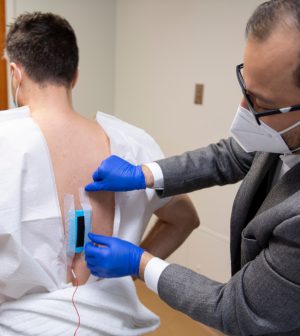- Skip Storing This Everyday Product in the Fridge Door
- Green Tea + B3 Pairing May Boost Brain Health
- Navigating Your Midlife Crisis: Embracing New Possibilities
- City Raccoons Showing Signs of Domestication
- Mapping the Exposome: Science Broadens Focus to Environmental Disease Triggers
- One Week Less on Social Media Linked to Better Mental Health
- Your Brain Changes in Stages as You Age, Study Finds
- Some Suicide Victims Show No Typical Warning Signs, Study Finds
- ByHeart Formula Faces Lawsuits After Babies Sickened With Botulism
- Switch to Vegan Diet Could Cut Your Greenhouse Gas Emissions in Half
Could Spinal Cord Stimulation Ease Depression?

Believe it or not, your spinal cord may be a pathway to better mood and even an end to depression, new research suggests.
Investigators at the University of Cincinnati stressed that their pilot study — to see whether tweaking the spinal cord can ease depression — is in its very early stages.
However, 20-minute sessions did seem to bring mental health benefits to participants, the team said.
As the scientists explained it, the spinal cord serves (among other functions) as a kind of neuronal highway, transmitting information from throughout the body to the brain’s mood centers.
The Cincinnati researchers theorized that an informational “overload” on this pathway might overwhelm the brain, playing a role in depression.
So, study lead author Dr. Francisco Romo-Nava designed a noninvasive spinal cord stimulation method that he has patented. Using this technology, he and his colleagues hoped to decrease the “noise” traveling along the spinal cord, offering some relief to an overtaxed brain.
“Spinal cord stimulation is thought to help the brain modulate itself as it should by decreasing the noise or decreasing the hyperactive signaling that may be in place during a depressive syndrome,” explained Romo-Nava, a research associate professor in the university’s department of psychiatry and behavioral neuroscience.
The current trial was small, just 20 patients diagnosed with depression.
Three times a week for eight weeks, half of the patients got 20 minutes of the spinal cord stimulation therapy, while the other half got a “sham” treatment, where their spines received an electrical current that was thought to be below the threshold needed for any effect.
Patients seemed fine with the level of current delivered, Romo-Nava said.
“We used a current that is so small that it’s about 10 times smaller than the one known to induce tissue damage,” he explained in a university news release. “So, that’s also pretty encouraging because there’s a lot to explore in terms of what is the optimal dose and session frequency.”
Patients who got the real treatment did seem to have greater reductions in depressive symptoms compared to those who got the sham treatment, the researchers said.
But because the study group was so small, it is just too early to draw any definite conclusions, the researchers said.
Side effects included some transient skin redness at the site where the spinal cord stimulation was given, and some itching or burning sensations that only lasted as long as the treatment session.
The findings were published Dec. 20 in Molecular Psychiatry.
“We need to be cautious when we interpret these results because of the pilot nature and the small sample size of the study,” Romo-Nava said. “While the primary outcome was positive and it shows therapeutic potential, we should acknowledge all the limitations of the study.”
More information
Find out more about depression at the American Psychiatric Association.
SOURCE: University of Cincinnati, news release, Dec. 20, 2023
Source: HealthDay
Copyright © 2025 HealthDay. All rights reserved.










